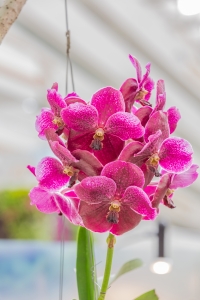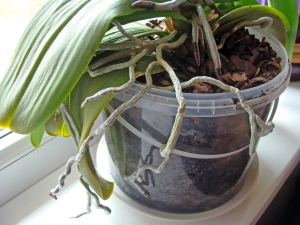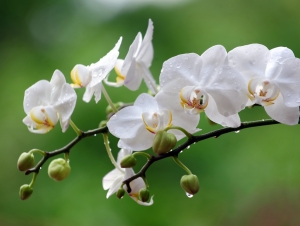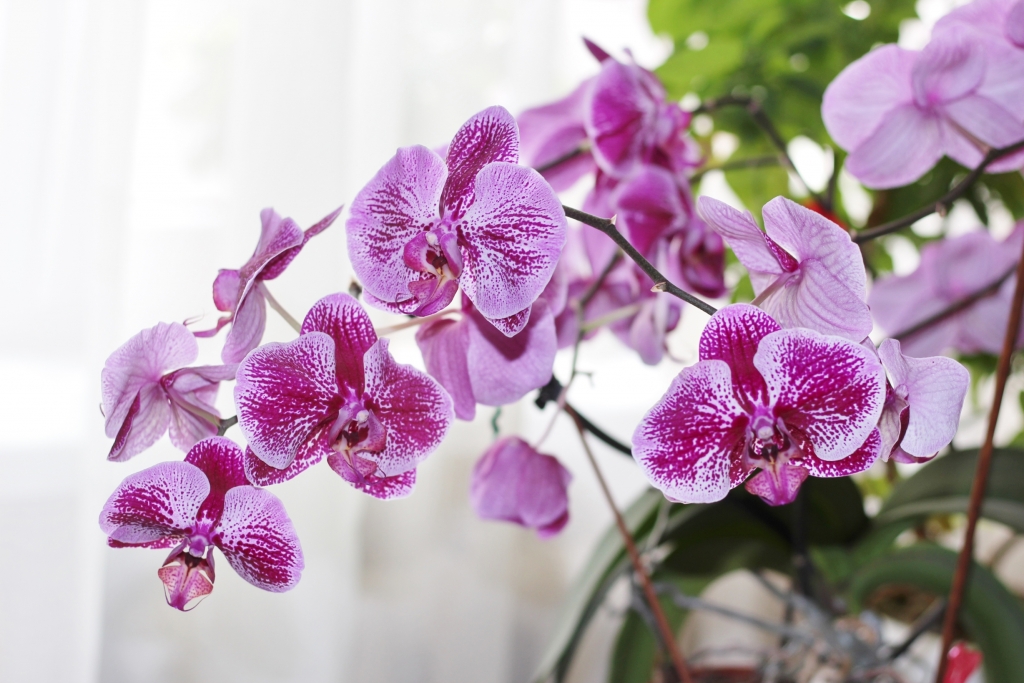There are 5 essentials to growing orchids indoors. The trick to growing orchids inside is getting the right one for the right location in the home. Light, temperature, humidity, air, water and fertilizer all play important roles in growing these beautiful plants for the office or home.
1) LIGHT
Orchids need light and is the most important aspect when growing indoors. Growers categorize them as low, medium and high light level requirements. Phalaenopsis (moth orchids) and paphiopedilum (slipper orchid) are considered low light. Ruffly-flowered Cattleya (corsage orchid) needs medium light; whereas Vanda and Brassavola require high levels of light.
 An easy way to tell if your orchid has sufficient lighting is by its leaves. A deep green leaf means the orchid is not receiving enough light. Not enough light is the most common reason for the plant’s failure to bloom. Finding the happy medium can be a challenge. In natural sunlight, learning how much light it will take before burning is key. Basically orchids grown under sufficient lighting have yellow-green foliage with strong upright growths. Orchids grow well in artificial lighting as well.
An easy way to tell if your orchid has sufficient lighting is by its leaves. A deep green leaf means the orchid is not receiving enough light. Not enough light is the most common reason for the plant’s failure to bloom. Finding the happy medium can be a challenge. In natural sunlight, learning how much light it will take before burning is key. Basically orchids grown under sufficient lighting have yellow-green foliage with strong upright growths. Orchids grow well in artificial lighting as well.
2) TEMPERATURE
Classified as either cool, intermediate or warm growing, orchids’ overall growth, especially for blooming, is dependent on the surrounding temperature.
Cool growing like a nighttime temp of 50°F and 70°F during the day.
Intermediate growing like a nighttime temp of 60°F and 70°F to 85°F during the day.
Warm growing like a nighttime temp of 65°F and 75°F – 85°F during the day.
Both intermediate and warm growing orchids during the summer can tolerate 85°F to 90°F if they have good air circulation. Most orchids need a fluctuation of 10 to 20 degrees between day and nighttime temperatures to trigger blooms.
3) AIR CIRCULATION & HUMIDITY
 Orchids love about 40% humidity. Central heating during the winter months and air conditioning in the summer months makes the environment dry. To increase the humidity, spray with a fine mist on both the tops and bottoms of the leaves in the morning, not evening, so the plants can dry out the rest of the day. Grouping the orchids in a tray of wet pebbles also raises the humidity around them. The water level should be just below the pot bottoms.
Orchids love about 40% humidity. Central heating during the winter months and air conditioning in the summer months makes the environment dry. To increase the humidity, spray with a fine mist on both the tops and bottoms of the leaves in the morning, not evening, so the plants can dry out the rest of the day. Grouping the orchids in a tray of wet pebbles also raises the humidity around them. The water level should be just below the pot bottoms.
Good, fresh circulating air makes for a happy orchid. Orchids will die if they do not get air, therefore are not grown in regular potting soil. The potting media needs to be open with very good drainage and sufficient moisture for the plant’s needs. Grated bark, stones and sphagnum moss allow both moisture and air for the plant and its roots to breath.
4) WATER
There are two separate components to watering, quantity and frequency. Water the orchids just as they dry out.
 Two ways to tell the potted orchid is just about dry is 1) the surface of the potting mix appears dry and the pot will feel lighter and 2) a wooden stake inserted in the middle of the potting mix comes out almost dry. Water the orchids until it drains freely from the drainage holes. This soaks the potting medium and flushes salt that natural accumulates. Depending on light water 2-4 times a month. A little trade secret an ice cube placed in the soil works great. Do not let orchids sit in standing water ever.
Two ways to tell the potted orchid is just about dry is 1) the surface of the potting mix appears dry and the pot will feel lighter and 2) a wooden stake inserted in the middle of the potting mix comes out almost dry. Water the orchids until it drains freely from the drainage holes. This soaks the potting medium and flushes salt that natural accumulates. Depending on light water 2-4 times a month. A little trade secret an ice cube placed in the soil works great. Do not let orchids sit in standing water ever.
The frequency of watering can be controlled by the type of pot. Clay pots are good for those who tend to water a lot or live in humid climates. Drier climates or those who do not water enough might use a plastic pot to hold moisture longer.
5) FERTILIZER
Orchids can grow and flower for long periods without fertilizer, but benefit with some level of feeding. Typically, feed once a week during the summer and every two weeks in the fall and winter. Most experienced orchid growers recommend no more than 1/2 the label recommended strength, no matter the type that is used.
 Water first to wet the potting medium before fertilizing. It’s best to use a fertilizer with little or no urea. The nitrogen in the urea needs to be converted first by soil organisms. Since most orchids do not grow in soil, the conversion is inefficient. Still, orchids grow best with a 20-20-20 formulation not high in nitrogen.
Water first to wet the potting medium before fertilizing. It’s best to use a fertilizer with little or no urea. The nitrogen in the urea needs to be converted first by soil organisms. Since most orchids do not grow in soil, the conversion is inefficient. Still, orchids grow best with a 20-20-20 formulation not high in nitrogen.
Another type of fertilizer not found in any formula is the love and care for the plants. Observing their beautiful existence daily allows for any adjustments and corrections needed in the above essentials. And pours forth an intangible force that makes their beauty shine even more.








